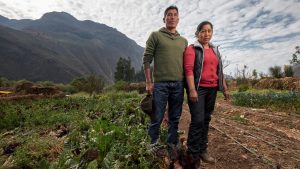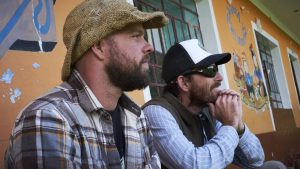Tuesday, October 31st, 2017...11:29 am
Are MIIS Alums using a New Model of Sustainable Development in Peru?
Full Article Published in Middlebury Magazine
Photographs by Brett Simison
OVER THE PAST HALF DECADE, in the Andes Mountains of southern Peru, two bearded Americans—a couple of Middlebury Institute graduates named Aaron Ebner MPA ’11, and Adam Stieglitz MPA ’11—have made the same harrowing trip hundreds of times. Their starting point is the city of Calca, where they live, and their destination is Lares, a district on the other side of a mountain pass—14,448 feet above sea level—where a group of indigenous, Quechua communities with Incan roots are scattered. Since 2009, Ebner and Stieglitz—under the auspices of their nonprofit organization, the Andean Alliance for Sustainable Development (AASD)—have worked and conducted research in the region, establishing long-term relationships with the campesinos who survive there by farming and raising animals on the steep mountainsides. Ebner (known locally as Ah-ron), Stieglitz (A-dam), and the AASD have, at this point, become household names.

Julio Cesar Nina and Yésica Cusiyupanqui had seen numerous NGOs come and go in their native Peru. What they’ve experienced with the Andean Alliance is a different story.
The AASD is a small, unique NGO. Its mission is to support community-led development projects. Unlike other NGOs, at least those working in the Andes, one of its primary tactics has been the establishment of deep trust-based relationships with the communities in which it works. Since Ebner and Stieglitz started the organization while they were graduate students at the Middlebury Institute of International Studies at Monterey, they have also made academic research and experiential education key components of the alliance’s model. Their approach relies heavily on the help of students who take part in their courses and programs.
International NGOs have traditionally followed and, in many cases, still follow a top-down model of development. In the cartoon version of this model, an NGO shows up in an isolated, poor (by Western metrics) place and tells its residents what they are missing, or what will improve their quality of life, or what skills they should learn. NGOs dig a well, or teach some classes, or do whatever it is that they determine the place needs, despite having never lived there. Then, like a traveling circus, they leave.
Ebner and Stieglitz are critical of this approach but admit that their own mindset when they arrived in Peru was not so different. They gave lip service to the idea of community-led development, but actually came to the Andes like nouveau eco-missionaries, with a plan to build greenhouses next to schools. They believed that this simple idea could immediately create significant improvements in people’s lives. Instead, over the next eight years, they were humbled, frustrated, resented. Some of the greenhouses were ignored or unused, the victims of changing school directors or a lack of community ownership. Ebner and Stieglitz had many sleepless nights wondering what they were doing with their lives, and if their efforts had any value or impact. They spent years without salaries. But they also were not afraid to acknowledge their failures, their misunderstandings, and to use those experiences to help them refine and refocus the alliance’s mission.
Gradually, the AASD has made a small but steadily positive impact. School greenhouse projects led to family greenhouse projects, which turned out to be much more successful and sustainable. (Since 2012, they have helped 65 families build them.) Beginning in 2014, they began emphasizing the experiential-education arm of their organization and started collaborating with Middlebury professors to create courses for both graduate and undergraduate students. Students did a semester of in-class preparation for the work they would do on site in Calca—during J-term or summer recess—then another semester of follow-up reflection and analysis. (The AASD has also conducted an independent research practicum every summer since 2015.) These projects have centered around topics related to social change and communication, climate change, or, this year, school greenhouse gardens. The AASD has then presented its findings to organizations like Calca’s regional office of economic development, ensuring that community members’ wants, needs, and concerns are addressed on the larger institutional and governmental stage.
Several Middlebury Institute alumni have traveled down to Calca and stayed with the AASD after their internships or independent studies ended, including, most notably, two current senior staff members: Gaelen Hayes, the experiential learning program manager, and Christopher Miller, the director of organizational development. Miller told me that he especially values how the AASD establishes long-term relationships with the people who live in the region. Their approach, he added, couldn’t be more different from big governmental or NGO development projects. “We’re not coming into these communities like Oprah: ‘You get a greenhouse! And you get a greenhouse! Everybody gets a greenhouse!’” Miller said. “We know that’s never going to work. Instead, we go to these community assemblies and present these ideas to everyone. Those who are really open to it, really see the benefit of it—that’s where you’ll see success.”
What is scalable, they say, is their hybrid model bridging experiential education with community-led development. Stieglitz believes it will revolutionize the future of education and cross-cultural exchange, and will spread around the world. He sees universities working with other small NGOs to support their grassroots
development efforts by sending students to help them. Students, in turn, have new hands-on and place-based learning opportunities. The model has endless possibilities, some of which have been piloted at Middlebury already: undergraduate students working with a regional economic development office to evaluate their programs, network with other experts in a particular field, and help the office adapt the program to make it better; and wraparound courses that precede and follow a student’s research done in Calca. “It’s not just about a three-week experience during J-term,” Stieglitz said. “It’s everything leading up to that and what comes after.” He imagines an evaluation class in which students design a way to evaluate one of the AASD’s programs, then go to Calca and carry it out; or a live case study, in which people in a community in Peru are involved in the class taking place at Middlebury. “It’s about building that cohesion,” he said. “Experiential education is adding value locally, in Peru.” But in their model, it’s “not just about students coming in and helping communities. There is also this bilateral flow, push and pull—what students are taking away from these brilliant sustainable communities as it relates to their studies.”
Read the full article published in Middlebury Magazine here.
…



